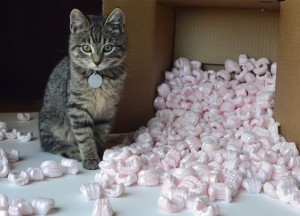 Maybe you’ve had it with your upstairs neighbor moving furniture at all hours of the night. Or, maybe that big promotion at work finally came through… in Omaha. Whatever the precipice, one thing is clear: moving is in your future.
Maybe you’ve had it with your upstairs neighbor moving furniture at all hours of the night. Or, maybe that big promotion at work finally came through… in Omaha. Whatever the precipice, one thing is clear: moving is in your future.
But have you thought about how best to move your cat? Sure, cats love boxes, but change is not the feline’s forte. From keeping your kitty safe while you pack, to physically transporting him from Point A to Point B, to helping him settle into your new digs, there is a lot to consider.
From Frisky to Fidgety
Before you even bring home the first box, it’s likely your cat knows something is about to change. Maybe it’s that you’ve started washing clothes that haven’t seen the light of day since 2012. Or maybe your feline has just picked up on the fact that something has changed with you. Cats are spooky like that.
You, in turn, have probably noticed that your cat’s a little more freaky than usual. Maybe he’s getting the 2 a.m. crazies more often than not, or maybe she’s staked her claim under the couch and isn’t budging.
Whatever the case may be, you need to remember that cats are not hip to change. Remember when you rearranged your living room and your cat bounced off the walls for weeks? Well times that by, like, infinity. Regardless of how your kitty handles the upcoming move, it’s your responsibility to help him or her through it.
Planning Ahead
In a perfect world, you have already crate trained your cat and have set up the crate (lined in cozy fabrics that smell of home) in a quiet area that will remain stable as long as possible.
If you haven’t crate trained your kitty, there’s no time like the present. The crate will be necessary for safe transport no matter how far you are moving, and your cat will likely appreciate a stable refuge from the chaos of packing.
That said, don’t worry if your cat prefers one of the many boxes and bags you’re using to pack. Cat’s are just as curious as they are annoyed by change.
Beyond creating a safe space for kitty, you’ll also want to consider a few other things…
Home Sweet (New) Home
Once the move is complete, you may want to consider the following:
Moving Your Cat Is Stressful
Moving is stressful for all of us, but it may be doubly-so for your cat. If there is anything we can do to help you both during your move, please let us know. And if you’re leaving the area, please let us know. We’d love to say good-bye and get your kitty’s medical records in order for your new vet. Maybe we can even make a referral.
Good luck!







Leave A Comment